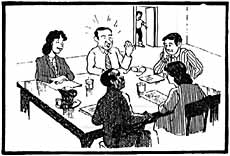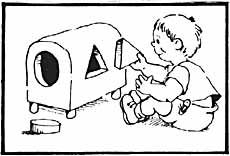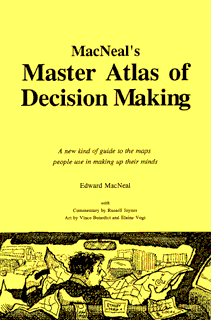Edward MacNeal
Author, Businessman, Scholar
| Welcome to the decision-making page. The focus here is on a coordinated view of decision making that identifies and then covers all possible forms, linkages, and uses thereof. The Book button takes you to edition data, a review, and an author's statement on MacNeal's Master Atlas of Decision Making. The title tells it all. The Master Atlas presents an organized view of all possible forms of decision making. The intention is to make it easy for the reader to tell which decision-making for any proposer or decider happens to be using (or trapped within). This is the only published works of its kind. The Articles button takes you to brief abstracts of not quite 20 articles on decision making in keeping with the view given above. The Other button take you to descriptions of three "books" (a summary, a workbook, and a long manuscript) complementing the Master Atlas, a description of a new decision-making book in progress, an offer to provide some teaching materials, and two opportunities to help. |



There is only one edition of MacNeal's Master Atlas of Decision Making: A New Kind of Guide to the Maps People Use in Making Up Their Minds (Concord, CA: ISGS, 1997), ISBN 0-918970-44-X, by Edward MacNeal with commentary by Russell Joyner and art by Vince Benedict and Elaine Vogt. 144 + xiv pages, 58 illustrations and 25 tables in the main text, glossary, other appendices, index.
An author's statement and the contents of Master Atlas follow the review.
Review:
Reviewer: Robert Ian Scott, Professor of English emeritus, University of Saskatchewan, Saskatoon, Canada, as filed at Amazon.com.
"Looking Before We Leap"
Edward MacNeal's "Master Atlas of Decision-Making" actually provides what its subtitle promises it will, "a new kind of guide to the maps people use in making up their minds." By "maps," he means mental maps, the ways in which we understand situations.
What we sense, understand, ask, and do depend on each other, and so these maps matter: they result from and affect our lives. With some ingeniously simple diagrams, MacNeal explains ways we can understand situations, and which patterns of language we use as we do, and so go on to make decisions.
For example, we may simply respond: 'if X happens, do Y.' We may react in terms of what we want: 'To get X, do Y,' with Y as a recipe explaining how to get that X, the result we want. Whether we should or do want that result or should try the recipe depends on what the recipe asks us to do, and at what costs. With MacNeal's sentence patterns and his diagrams illustrating them, he gives us a set of recipes for thinking, and so for making intelligent decisions.
Author's statement:
I began my study of decision making in January 1946 on the North Atlantic coming home from WWII in Europe. The study led me in 1949 into the University of Chicago's "program of education and research in planning" and my interest in decision making has continued ever since.
Other than my Master Atlas, books and articles on decision making, of which I've studied a great many, fail in my opinion to address decision-making activity in adequate scope. Each sees only a small portion of the activity and interprets it according to the prevailing outlook in the author's primary field.
Thus economists, sociologists, psychologists, educators, business administrators, public administrators, lawyers, game theorists, and statistical decision specialists all tend to treat their incomplete views as covering the whole of decision making. Some, especially economists, are acutely aware that their usual way of looking at decisions breaks down when applied to real events. Their efforts to resolve the resulting discrepancies remind me of the efforts of astronomers to retain Ptolemy's geocentric theory. As data showed the planets didn't follow the paths the theory had predicted, they introduced epicycles (circles within circles) and other devices to try to heal the theory, all to no avail. In the end the more general heliocentric theory was needed.
What I attempt to do in the Master Atlas is provide a sound framework large enough to encompass everyone's point of view, because I believe each does describe some actual decision making. Although it has not been my intent, and I don't dwell on it at any length, the very effort to provide a total structure necessarily reveals how limited most views have been.
I'm aware from my work in mathsemantics (which attempts to bridge the academic areas of math and semantics, as embodied in English, linguistics, and other humanities) that no discipline easily adopts a view transcending its own.
Yet, as the Master Atlas shows, ordinary people switch between decision-making logics with extraordinary ease. Evolution gave all of us the ability. In our excuses, and in law, we mainly use what I call "responsive" demalogic (dema, rhymes with schema and edema, from DEcision MAking [hear it – a 132k .wav file]). In minor personal choices we mainly use what I call "absolute" logic. In our gripes, we fault others for not observing "reciprocal" demalogic. Yet, ask almost anyone about decision-making theory in a serious or academic way and they almost always profess what I call "goal-directed" demalogic.
Indeed, people shift demalogics so effortlessly that usually nobody notices. When we do notice, we find the shifts confusing. I believe the confusion is just lack of training. An exhaustive and disciplined search shows that only 20-odd demalogics exist, and that they form a clear structural progression. Though this is more demalogics than generally recognized, the entire set is already in almost everybody's practical repertoire, produced by evolution. And what's so tough about 20, anyway in a world with hundreds of television channels? It's time we had a decision-making theory that matched practice. MacNeal's Master Atlas contains such a theory.
Contents of Master Atlas:
The book began life as a series of ten articles, the brief descriptions of which provide a somewhat sterile description of the subjects covered.
Work on the overview presented in the Master Atlas produced many "unpublished" works.
Availability:
Many libraries have ETC: A Review of General Semantics.
Back issues of ETC, especially the more recent ones, can be obtained from the publisher: International Society for General Semantics (ISGS), publisher of ETC.
Note: If ISGS is out of stock of any issue in items #6-#15, you can obtain all of them as one unit in the book MacNeal's Master Atlas of Decision Making: A New Kind of Guide to the Maps People Use in Making Up Their Minds (Concord, CA: ISGS, 1997), ISBN 0-918970-44-X, available through most bookstores and internet retailers. For fast delivery, though, try ISGS.
All the articles below (except the French translation) appeared in ETC: A Review of General Semantics. The title and subject of each article is given, followed by the ETC volume and issue numbers, season and year, unless otherwise specified. The author is Edward MacNeal unless otherwise specified.
1.
"Foundations of a Theory of Decision Making": Paper given at the opening session of the University of Chicago conference on general semantics, June 22, 1951. One can distinguish between three patterns of decision making: responsive, goal-directed, and originative. (54.3, Fall 1997)
2.
"Semantics and Decision Making": One can distinguish five levels of decisional structure: elements, basic patterns, compound patterns, processes, and systems, and one can distinguish between structures within the levels. Treating all decisions as goal-directed is a mistake. (40.2, Summer 1983)
3.
"SEMANTIQUE ET PRISE DE DECISION": This is a translation into French by Pierre Rouve of article #2, published as a 28-page booklet, ISBN 2-9502621-0-4 (Castres: Editions Plein Ciel, 1988).
4.
"The Flaw": English lacks simple terms to distinguish between what can and cannot be changed. With regard to what can be changed, English makes an unrealizable distinction between action and consequences. All actions have consequences and one cannot have one without the other. This fundamental flaw infects almost all decision-making activity. (41.3, Fall 1984)
5.
"When Does Consciousness of Abstracting Matter the Most?": Apart from decisions, we have no deliberate effect upon our world. Therefore, consciousness of abstracting matters the most when making decisions. To visualize our units of choice we must preview alternaquences. (43.1, Spring 1986)
Note: The articles numbered 6 through 15 below formed a series titled "MacNeal's Master Atlas of Decision Making." They were published together under that title in 1997 as a book. The subtitles and subjects of the articles are shown below.
6.
"Groundwork": When we deliberate about a decision, we deal with our maps of the decision-action territory. Each map projects a point of view or perspective. Each perspective serves some uses well and introduces distortions. To explore these maps we must overcome three hazards. (44.3, Fall 1987)
7.
"Groundwork" continued: One can distinguish between seven levels of decision-making: subdecisional events, basic patterns, compound patterns, basic linkages, interpersonal linkages, systems, and comparative demalogics (decision-making logics). Subdecisional events do separate into situations and alternaquences, but alternaquences don't separate into actions and consequences except in language. (44.4, Winter 1987)
8.
"Logics for the Single Decision": Basic patterns use one reason for one action. The two simplest demalogics (decision-making logics) of this kind are the absolute and action-comparative patterns. The most touted is the goal-directed pattern. (45.1, Spring 1988)
9.
"Logics for the Single Decision" continued: Despite its utility, the least recognized basic pattern is the originative. Compound patterns, such as the scorecard, involve multiple reasons for one action. (45.2, Summer 1988)
10.
"Logics for Interconnected Decisions": Basic linkages need involve only one decider, and include the transformative, the recursive, and, unavoidably, the allocative linkage. (45.3, Fall 1988)
11.
"Logics for Interconnected Decisions" continued: The human interpersonal linkages include the propositional, mutual, and reciprocal. Organizational demalogic adds four extrahuman linkages. (45.4, Winter 1988)
12.
"Applying Demalogics": "Selecting demalogics in an organized way helps most in complicated decisions....each demalogic suffers from different kinds of possible error,... Failure to forecast the overall effect of our actions leads the list of our errors." (46.1, Spring 1989)
13.
"Applying Demalogics" continued: Responsibility spawns a demalogical [decision-making-logical] tug of war. Words carry demalogical clues, but decision goes beyond words. "A complete decider would know all the demalogics and knowingly pick the best ones for the circumstances." (46.2, Summer 1989)
14.
"Appendices": The first appendix presents all the demalogical formulas and diagrams in one place. The second is a glossary. (46.3, Fall 1989)
15.
"Appendices" concluded: The third appendix is an example of demalogical explication of a text. The fourth presents sample demalogical dictionary entries of ordinary words. The fifth is an abbreviated demalogical thesaurus. (46.4, Winter 1989)
16.
"The Most 'Consequential' Elementalism": The verbal split between actions and consequences infects almost all verbs and many nouns, yet cannot be carried out in practice, and hence is an "elementalism." It has more practical consequences than "mind-body," "space-time," or any other elementalism. The term "alternaquence" offers one antidote. (in Developing Sanity in Human Affairs, S.P. Kodish and R.P. Holston, eds, prepared under the auspices of Hofstra University [Westport, CT: Greenwood, 1998]).
17.
"Rational-Behavior Therapy as Correcting Demamaps" by Gardner Gateley: "Awareness of irrational beliefs functioning as demamaps (decision-making maps) appears to offer great possibilities for improved feelings, more productive behavior, and sane living in general." (56.3, Fall 1999)
18.
"How We Might Use Demamaps in Therapy" by Gardner Gateley: Here Dr. Gateley uses examples from the treatment of worry and stuttering to demonstrate how "counseling and psychotherapy often consist of changing a client's demamaps." (57.1, Spring 2000)